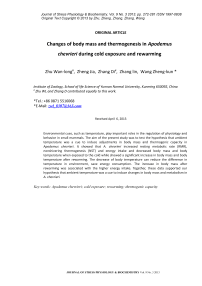Changes of body mass and thermogenesis in Apodemus chevrieri during cold exposure and rewarming
Автор: Zhu Wan-Long, Zheng Jia, Zhang Di, Zhang Lin, Wang Zheng-Kun
Журнал: Журнал стресс-физиологии и биохимии @jspb
Статья в выпуске: 3 т.9, 2013 года.
Бесплатный доступ
Environmental cues, such as temperature, play important roles in the regulation of physiology and behavior in small mammals. The aim of the present study was to test the hypothesis that ambient temperature was a cue to induce adjustments in body mass and thermogenic capacity in Apodemus chevrieri. It showed that A. chevrieri increased resting metabolic rate (RMR), nonshivering thermogenesis (NST) and energy intake and decreased body mass and body temperature when exposed to the cold while showed a significant increase in body mass and body temperature after rewarming. The decrease of body temperature can reduce the difference in temperature in environment, save energy consumption. The increase in body mass after rewarming was associated with the higher energy intake. Together, these data supported our hypothesis that ambient temperature was a cue to induce changes in body mass and metabolism in A. chevrieri.
Apodemus chevrieri, cold exposure, rewarming, thermogenic capacity
Короткий адрес: https://sciup.org/14323773
IDR: 14323773
Текст научной статьи Changes of body mass and thermogenesis in Apodemus chevrieri during cold exposure and rewarming
Phenotypic plasticity is refers to the specific genotype response to different phenotype characteristics under different environmental conditions, which provide the possibility of making quick and effective reaction in response to environmental changes in mammals (Ellegren and Sheldon, 2008). Phenotypic plasticity can enhance the adaptability of various environment of mammals, and to improve the survival ability (VéZina and Williams, 2003). In order to meet the environmental stress, small mammals often produced adapt changes so as to meet the new challenges brought about by the survival of the fittest. Temperature influences animals’ body mass, energy budget, thermogenesis and phenotypic plasticity (William and Christain, 2006). There were lot of studies about the temperature in mammals reported (Bozinovic et al., 2004; Fuglesteg et al., 2006; Mustonen et al., 2004). Thermoregulation is the ability of an organism to keep its body temperature within certain boundaries, even when the surrounding temperature is very different (Romanovsky, 2007).Resting metabolic rate (RMR) is the amount of energy expended daily by humans and other animals at rest (Müller et al., 2001). To cope with winter or cold conditions, some small mammals reduced their overall body mass and body fat and enhanced nonshivering thermogenesis (NST) (Bartness et al., 2002).
The Hengduan Mountains region is located the boundary between the Palaearctic region and the Oriental region. It is alpine with high mountains and gorges; The diversity and abundance of mammals is high and it is considered to be “the harbor in fourth ice age”. Therefore small mammals may differ from those from other regions. A. chevrieri is the inherent species in the Hengduan mountains region. Evaporative water loss and seasonal variations of body mass, thermogenesis and digestive tract morphology were studied (Zhu et al., 2008, 2012). Environmental factors, such as cold, is effective cues that influence body mass and thermogenesis in A. chevrieri (Zhu et al., 2011). However, we no nothing that body mass and thermogenesis under warm temperature. The present study was designed to investigate the role of cold acclimation and rewarming on the energy metabolism and body mass regulation in A. chevrieri. We hypothesized that ambient temperature was an important cue to influence body mass and energy metabolism.
MATERIALS AND METHODS
Samples
A. chevrieri were captured in farmland (26°15 ´~26°45´N; 99°40´~99°55´E; altitude 2,590m) in Jianchuan County, Yunnan province, 2010. Average temperature is 9.1oC each year, minimum average temperature was -4.0oC in January, maximal average temperature was 24.1oC in July.
A. chevrieri were breed in School of life Science of Yunnan Normal University, park in plastic box(260mm×160mm×150mm), one in a box without any bedding material, and were maintained at the room temperature of 25±1°C, under a photoperiod of 12L:12D (with lights on at 0800). After 1 month stabilization, subjects were assigned to cold (5 ± 1°C) for 4 week and transferred to 25±1°C for further 4 weeks, on days 0, 7, 14, 21, 28, 35, 42, 49 and 56, different individuals were sacrificed and these 9 groups were named C0, C7, C14, C21, C28, RW7, RW14, RW21 and RW28, respectively (C, cold; RW, rewarming), samples of each group were 7. Photoperiod was kept at 12L: 12D throughout the study.
Measurement of resting metabolic rates
Metabolic rates were measured by using an AD ML870 open respirometer (AD Instruments, Australia) at 25 o C within the TNZ (thermal neutral zone), gas analysis were using a ML206 gas analysis instrument, the temperature was controlled by SPX-300 artificial climatic engine (±0.5 o C), the metabolic chamber volume is 500ml, airflow rate is 200 ml/min. A. chevrieri were stabilized in the metabolic chamber for at least 60 min prior to the RMR measurement, oxygen consumption was recorded for more than 120 min at 1 min intervals. Ten stable consecutive lowest readings were taken to calculate RMR (Zhu et al, 2011). The method used for calculating the metabolic rate is detailed in Hill (1972):
MR _ FR x (FiO2 - FeO2) - FR x FeO2 x (FeCO2 - FiCO2) ~ l-FeO2
Note: FR = flow rate (ml/min), FiO2 = O2 input fractional concentration, FiCO2 = CO2 input fractional concentration, FeO2 = O2 excurrent fractional concentration, FeCO2 = CO2 excurrent fractional concentration.
Nonshivering thermogenesis (NST) was induced by subcutaneous injection of norepinephrine (NE) (Shanghai Harvest Pharmaceutical Co. Ltd) and measured at 25 o C. Two consecutive highest recordings of oxygen consumption more than 60 min at each measurement were taken to calculate the NST (Zhu et al, 2011). The doses of NE were approximately 0.8-1.0 mg/kg according to dosedependent response curves that were carried out before the experiment and the equation described by Heldmaier (1971) : norepinephrine dosage (mg/kg)=6.6M -0.458 (g).
Energy intake
Energy intake for each group was measured for 7 days (Song and Wang 2002), and food were provided ad libitum . Animals were feeding with fix quantify food at same time, next day weighted animal body mass, collected residual food. Residual food was dryness in at 65 o C for at least 72 h. Energy contents of food were measured by YX-ZR/Q automatic calorimeters instrument (U-therm Industry Co. Ltd. Changsha, China). The calorie of the diet fed to these animals was 18.0±0.8 kJ/g. The calculation of energy intake was according to corresponding reports (Drozdz 1975): Energy intake (KJ/d) =food (g/d)* energy content (KJ/g).
Statistical analysis
Data were analyzed using SPSS 15.0 software package. Prior to all statistical analyses, data were examined for assumptions of normality and homogeneity of variance, using Kolmogorov-Smirnov and Levene tests, respectively. Body mass, body temperature, RMR, NST and energy intake were analyzed by One-way ANOVA or ANCOVA.
Results were presented as mean ± SEM, and P < 0.05 was considered to be statistically significant.
RESULTS
Body mass and body temperature
During the first 4weeks, body mass in A. chevrieri showed a significant decrease (P<0.05). After rewarming, A. chevrieri showed a steady increase in body mass (P<0.05). Over the course, significant differences were found within treated groups (F=13.36, P<0.01, Fig 1).
During the first 4weeks, body temperature in A. chevrieri showed a significant decrease (P<0.05). After rewarming, A. chevrieri showed a steady increase in body temperature (P<0.05), and return to the level of 0 day. Over the course, significant differences were found of body temperature in A. chevrieri (F=9.54, P<0.01, Fig 2).
RMR, NST and energy intake
RMR (mlO 2 /g·h) was influenced by ambient temperature (Fig 3). RMR in A. chevrieri increased significantly and was 38.01% higher than that of 0 day (t=5.32, P<0.01) and returned to the level of 0 day in the first week after rewarming (t=-0.54, P>0.05). During the course of cold acclimation and rewarming, there were significant differences in RMR in A. chevrieri (F= 11.24, P<0.01).
NST in A. chevrieri increased significantly in the first 4 weeks (F=16.37, P<0.01) and lower than the level of 0 day in the first week after rewarming (F=6.65, P<0.01). During the course of cold acclimation and rewarming, there were significant differences in NST in A. chevrieri (F= 20.32, P<0.01, Fig 4).
Energy intake in A. chevrieri significantly increased in the second week compared to the control (t=-3.62, P<0.01; Fig 5). In the forth week of cold acclimation, energy intake was 31.86% higher than that in 0 day. When A. chevrieri returned to the warm conditions, energy intake was still higher than that in the control in the 5-6 week, but there were no longer differences from the forth week (P>0.05).
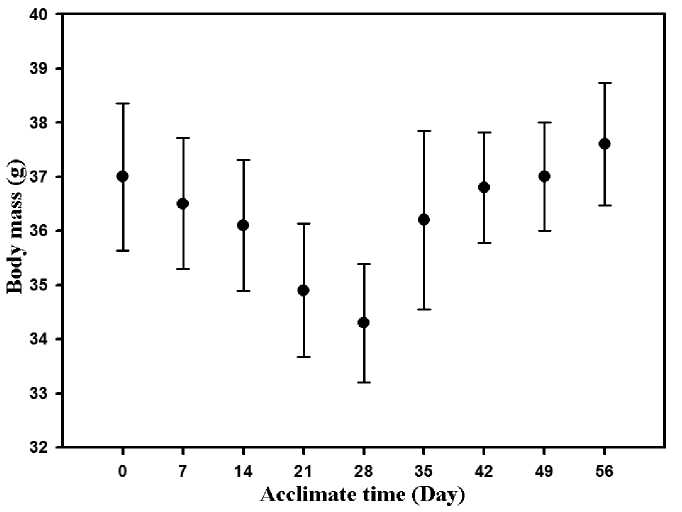
Figure 1 Effects of cold exposure and rewarming on body mass in A. Chevrieri
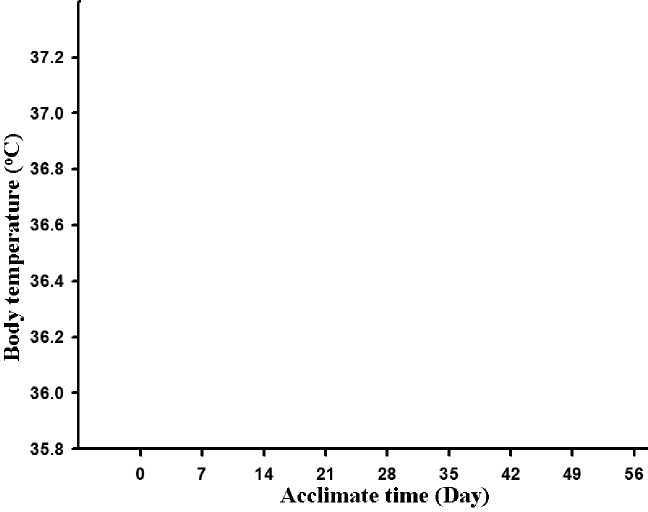
Figure 2 Effects of cold exposure and rewarming on body temperature in A. chevrieri
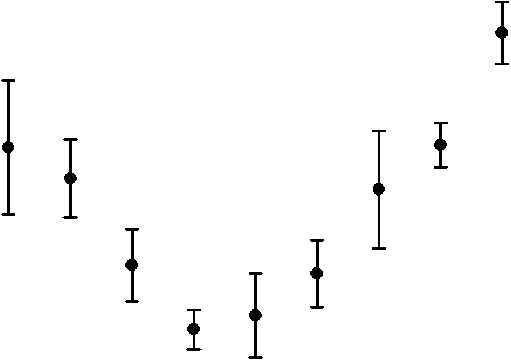
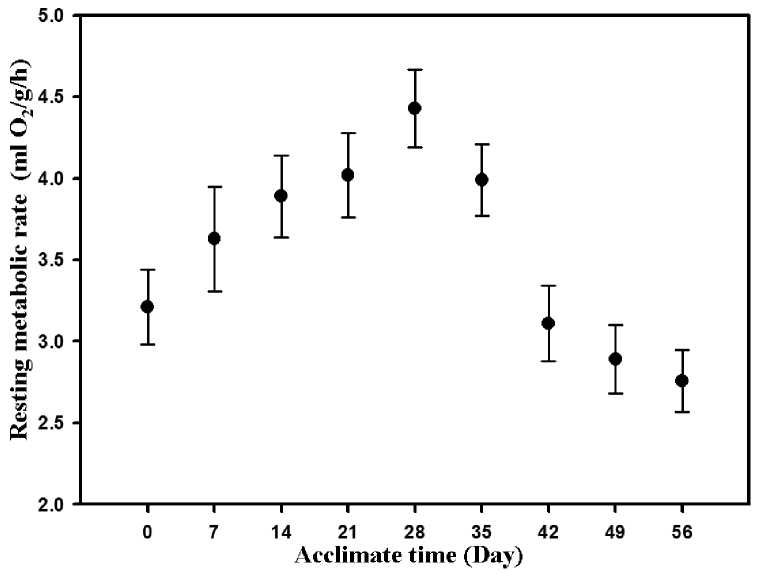
Figure 3 Effects of cold exposure and rewarming on resting metabolic rate in A. chevrieri
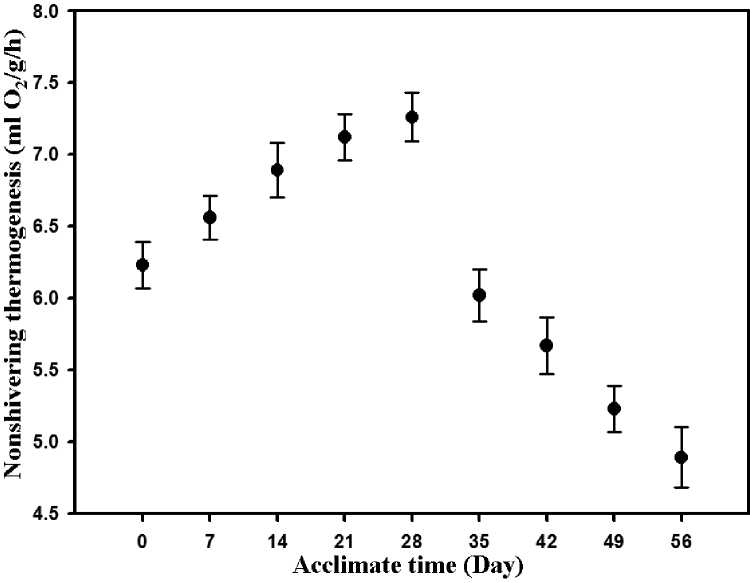
Figure 4 Effects of cold exposure and rewarming on nonshivering thermogenesis in A. chevrieri
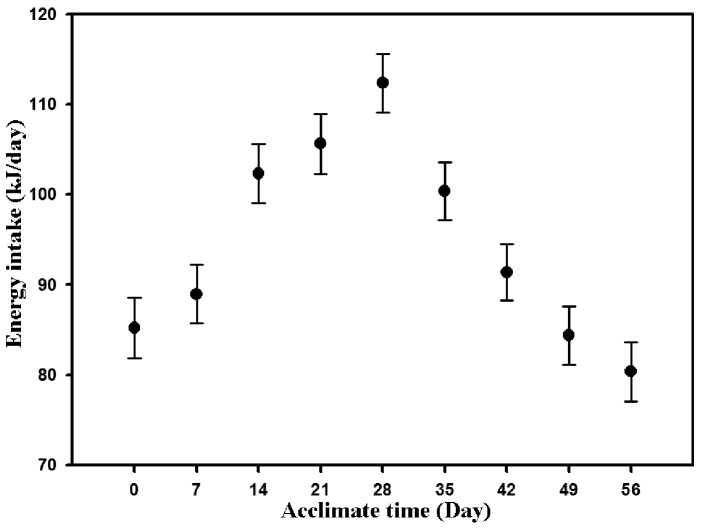
Figure 5 Effects of cold exposure and rewarming on energy intake in A. chevrieri
DISCUSSION
Body mass and body temperture
Body mass showed seasonal variation in many small mammals were the adaptation of energy adapt and energy demand, changes of body mass were close to the improvement of adaptation ability under the cold environment (Swanson, 2001). Many small mammals reduced body mass in winter, which is considered to be a lack of food and in a cold-stressed period by reducing the total energy demand, showed a energy strategy to adapt to the environment (Lovegrove, 2005), such as Meriones unguiculatus (Li and Wang, 2005a) and Microus brandti (Li and Wang, 2005b) . In the present study, In the face of environmental stress, A. chevrieri can adjust the body mass, total energy consumption, and respond to environmental pressures, body mass decreased under cold exposure, and increased when rewarming, showed that body mass in A. chevrieri exhibited plasticity regulation under temperature acclimation, Plasticity of body mass was adapted to the climate characteristics of daily temperature phase in Hengduan Mountains region, when the ambient temperature is reduced, decreased body mass can reduce energy demand (Zhu et al., 2008).
Regulation of body temperature in small mammals were closely related to energy utilization, distribution, ability, life history strategies and evolutionary approach, reflecting the animal’s adaptive model and physical ability to the environment (Shane, 2011). When mammals encounter of environmental change, they need to take corresponding countermeasures to cope with changes in the environment, some rodents showed obvious seasonal variation of body temperature, such as Cricetulus migratorius (Haim and Martinez, 1992). When the external environment change, mammals can adjust physiological ability, maintain stability of its internal environment, which close to the initial or "normal" level, but this kind of adaptive adjustment ability is limited, even the mammals may be lost body temperature regulation under extreme temperatures (Li and Wang, 2005a).
In the whole process of temperature acclimation, body temperature in A. chevrieri appeared certain adaptability fluctuation when the environmental temperature changes, body temperature drops gradually under cold exposure and increased when rewarming, which indicated that the plasticity of the temperature change with temperature regulation is reversible. Lower body temperature can reduce the difference in temperature in special environment and save energy consumption (Li and Wang, 2005b). RMR and NST
Resting metabolic rate is an important index to study the physiological ecology, can reflect the differences of energy consumption between species and the individual level, has important significance in animal adaptation to environment (McNab, 1997), which was influenced by some factors, such as ambient temperature, food (Terblanche et al., 2007), and season changes (Klaus et al., 1988). There are two types of heat production in mammals, namely the obligatory thermogenesis and facultative thermogenesis (Himms-Hagen, 1989), non-shivering thermogenesis (NST) belongs to the facultative thermogenesis, was a without muscle activity and increase the heat capacity mode. It showed seasonal variation in NST in small mammals, which showed adaptation to the cold environment (Jansky, 1973), many small mammals increased RMR and NST under cold acclimation (Himms-Hagen, 1986). In the whole process of temperature acclimation, RMR and NST in A. chevrieri showed plasticity as ambient temperature changes, when the environmental temperature changes, A. chevrieri adjust heat production ability to adapt to the changed environment temperature. RMR and NST increased were to cope with cold, and, reduced the heat production ability under warm environment, in order to reduce the physiological burden (Merritt et al., 2001).
Energy intake
Balance between energy intake and energy consumption is essential to the survival and reproduction in mammals (Bozinovic and et al., 2004), which depended on the interaction of energy intake, digestion and energy distribution, thus changing heat production, growth, survival, reproduction (Speakman, 2005). Energy balance showed significant seasonal variations in small mammals (Rousseau et al., 2003). Facing the change of environmental factors, the organism through regulating the physiological and ecological characteristics of their own, in order to keep the dynamic balance between energy intake and consumption (Johnston and Bennett, 1996). In the present study, energy intake in A chevrieri showed the corresponding changes with temperature changes in the external environment, clod temperature stimulated A chevrieri increased energy intake to meet the increasing heat and energy consumption, so as to maintain the dynamic balance of energy. In addition, A chevrieri decreased energy intake during rewarming. Energy intake in Apodemus chevrieri increased significantly under cold exposure, while RMR and NST also increased significantly, which indicated that increasing energy intake can compensate for increase of heat production and other physiological activitie under the condition of low temperature, in order to maintain the relative balance of energy metabolism and stable of body mass (Duarte et al, 2010).
In conclusion, All of these results indicated decrease of body temperature can reduce the difference in temperature in environment, save energy consumption. The increase in body mass after rewarming was associated with the higher
RMT, NST and energy intake. Together, these data supported our hypothesis that ambient temperature was a cue to induce changes in body mass and metabolism in A. chevrieri.
ACKNOWLEDGMENTS
This research was financially supported by National Science Foundation of China (No. 31260097), Project of Basic research for application in Yunnan Province(2011FZ082).
Список литературы Changes of body mass and thermogenesis in Apodemus chevrieri during cold exposure and rewarming
- Bartness, T.J., Demas, G.E., Song, C.K. (2002) Seasonal changes in adiposity: the roles of the photoperiod, melatonin and other hormones, and sympathetic nervous system. Experimental Biology and Medicine, 227: 363-376.
- Bozinovic, F., Bacigalupe, L.D., Vásquez, R.A., Visser, G.H., Veloso, C., Kenagy, G.J. (2004) Cost of living in free-ranging degus (Octodondegus): seasonal dynamics of energy expenditure. Comp Biochem Physiol, 137(3): A597-604.
- Duarte, L.C., Vaanholt, L.M., Sinclair, R.E., Gamo, Y., Speakman, J.R. (2010) Limits to sustained energy intake XII: is the poor relation between resting metabolic rate and reproductive performance because resting metabolism is not a repeatable trait? J Exp Biol, 213(2): 278-287.
- Haim, A., Martinez, J.J. (1992) Seasonal acclimatization in the migratory hamster Cricetulus migratorius the role of photoperiod. J. Therm. Biol. 7 (6): 347 -351.
- Heldmaier, G. (1971) Nonshivering thermogenesis and body size in 567 mammals. J. Comp. Physiol., 73: 222-248.
- Hill, R.W. (1972) Determination of oxygen consumption by use of the paramagnetic oxygen analyzer. J. Appl. Physiol., 33: 261-263.
- Himms-Hagen, J. (1986) Brown adipose tissue and cold-acclimation. In: Trayhurn P, Nicholls DGed. Brown Adipose Tissue. London: Edward Arnold (Publishers) Ltd, 214 -268.
- Himms-Hagen, J. (1989) Role of thermogenesis in the regulation of energy balance in relation to obesity. Journal of Physiology and Pharmacology, 67(4): 394-401.
- Jansky, L. (1973) Nonshivering thermogenesis and its thermoregulatory significance. Biol. Rev., 48: 85-132.
- Johnston, I.A., Bennett, A.F. (1996) Animals and temperature: phenotypic and evolutionary adaptation. society for experimental biology. Cambridge University Press.
- Klaus, S., Heldmaier, G., Ricquier, D. (1988) Seasonal acclimation of bank voles and thermogenic properties of brown adipose tissue mitochondria. J. Comp. Phyiol., 158: 157 -164.
- Li, X.S., Wang, D.H. (2005a) Seasonal adjustments in body mass and thermogenesis in Mongolian gerbils (Meriones unguieulatus): the roles of short Photoperiod and cold. J Comp Physiol, 175: 593-600.
- Li, X.S., Wang, D.H. (2005b) Regulation of body weight and thermogenesis in seasonally acclimatized Brandt’s voles (Microtus brandti). Horm Behav, 48: 321 -328.
- Lovegrove, B.G. (2005) Seasonal thermoregulatory responses in mammals. Journal of Comparative Physiology, 175: 231-247.
- McNab, B.K. (1997) On the utility of mammalian rates of basal rate of metabolism. Physiol. Zool., 70: 718 -720.
- Merritt, J.F., Zegers, D.A., Rose, L.R. (2001) Seasonal thermogenesis of southern flying squirrels (Glaucomys volans). J Mammal, 82: 51 -64.
- Müller, B., Merk, S., Bürgi, U., Diem, P. (2001) Calculating the basal metabolic rate and severe and morbid obesity. Praxis, 90 (45): 1955-1963.
- Romanovsky, A.A. (2007) Thermoregulation: some concepts have changed. Functional architecture of the thermoregulatory system. Am J Physiol Regul Integr Comp Physiol., 292(1): R37-46.
- Rousseau, K., Actha, Z., Loudon, A.S. (2003) Leptin and seasonal mammals. Journal of Neuroendocrinology, 15(4): 409-414.
- Shane, K.M., Andrea, F., Leith, C.R.M., Peter, R.K., Graham, M., Duncan, M. (2011) Minimum daily core body temperature in western grey kangaroos decreases as summer advances: a seasonal pattern, or a direct response to water, heat or energy supply? The Journal of Experimental Biology. 214(18): 1813-1820.
- Speakman, J.R. (2005) Review body size, energy metabolism and lifespan. The Journal of Experimental Biology, 208: 1717-1730.
- Swanson, D.L. (2001) Are summit metabolism and thermogenic endurance correlated in winter-acclimatized passerine birds? Comp. Physiol., 171: 475 -481.
- Terblanche, J.S., Janion, C., Chown, S.L. (2007) Variation in scorpion metabolic rate and rate-temperature relation: implications for the fundamental equation of the metabolic theory of ecology. Journal of Evolutionary Biology, 20: 1602 -1612.
- William, E.B., Christain, M.H. (2006) Evolutionary response to rapid climate change. Science, 312(5779): 1477-1478.
- Zhu, W.L., Jia, T., Lian, X., Wang, Z.K. (2008) Evaporative water loss and energy metabolism in two small mammals, voles (Eothenomys miletus) and mice (Apodemus chevrieri) in Hengduan mountains region. J. Therm. Biol., 33: 324-331
- Zhu, W.L., Wang, B., Cai, J.H., Lian, X., Wang, Z.K. (2011) Thermogenesis, energy intake and serum leptin in Apodemus chevrieri in Hengduan Mountains region during cold acclimation. J. Therm. Biol., 36(3): 181-186.
- Zhu, W.L., Yang, S.C., Zhang, L., Wang, Z.K. (2012) Seasonal variations of body mass, thermogenesis and digestive tract morphology in Apodemus chevrieri in Hengduan mountain region. Anim. Biol., 62: 463-478.

